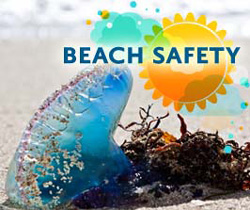It's a New Day in Public Health.
The Florida Department of Health works to protect, promote, and improve the health of all people in Florida through integrated state, county, and community efforts.
Staying Safe While Building Sandcastles
July 24, 2013

There is no denying, Florida has beautiful beaches. Whether you dream of lying on sugar-white crystal sands in the Southeast region or prefer the smooth brown sand of the Gulf coast, nothing is more relaxing than inhaling refreshing salt water air while surrounded by inviting blue waters.
However, going to the beach poses safety risks. Residents and visitors should watch for dangers when planning a fun summer family outing to Florida's signature beaches, including polluted swimming areas, dangerous marine life, and especially drowning.
Pollution
Spilled sewage can be a serious beach problem, as some sewer systems overflow into rivers that eventually release unpleasant content into our swimming water. If swallowed, or exposed to eyes or open wounds, this pollution can allow infectious microorganisms like bacteria, viruses and parasites to enter our bodies. On very rare occasions, these pathogens can produce diseases like dysentery, hepatitis, cholera and typhoid fever. Usually though, infection from polluted waters affects us in the way food poisoning would: nausea, stomach cramps, vomiting, headaches and fever. The infection tends to dissipate on its own, but not before turning your beautiful beach day into a distressing experience.
Pollution can also result from trash left behind by visitors and recent storms. To help keep beaches free from trash pollution, remember to reuse and recycle the items you bring to the beach, or throw them away in public trash containers. Not only does this protect future beachgoers from swimming amongst garbage, it also prevents pollution from floating farther into the ocean, where it can endanger fish, turtles, dolphins and other wildlife.
Always check your local beach advisories before heading out for a family excursion to make sure the beach is safe for swimming. The Healthy Beaches Program at the Florida Department of Health (DOH) monitors water quality at beaches in 30 coastal Florida counties at least once every two weeks. Swim advisories are posted if the water quality is not up to public health standard.
Marine Life
Living in sunny Florida means it's easy to forget that when it comes to the ocean, we are simply visitors. Our coasts are home to innumerable different species of marine life. Though most are harmless, many have the ability to sting and bite. These include Portuguese man-of-war, jellyfish, fire corals, catfish and sea urchins. It is important to avoid contact with these animals at all costs. Stingrays and sharks are especially dangerous, and necessary precautions must be taken to prevent serious injury.
The following steps should be taken to prevent a stingray attack:
- Perform the "stingray shuffle" when first getting into the water. Shuffle your feet forward, one at a time. This creates vibrations which alert nearby stingrays that you are there. Do not stomp down into the sand, as you can accidentally step on one, prompting an attack.
- Poke the area around you with a stick to scare off surrounding stingrays.
- Be aware that stingrays tend to travel together. If you see one, there may be several in the area.
Like most ocean life, stingrays only sting if they feel threatened; while injuries can be very painful, they are rarely fatal.
Sharks are also a natural part of Florida's aquatic ecosystem. Though Jaws portrayed sharks as a man-hunting menace and scared you as a kid, attacks on humans are often a case of mistaken identity. They are extremely rare and avoidable.
The following are common ways to avoid a shark attack:
- When in the water, stay in close groups. Sharks are more likely to attack a solitary swimmer.
- Always remain relatively close to the shore, which places you closer to someone who could help in case of an attack.
- Remember that sharks are most active during darkness or twilight hours. Avoid being in the water during this time.
- Sharks have an acute sense of smell, and the scent of blood makes them more likely to attack. Do not enter the water if bleeding from an open wound.
- Do not wear shiny jewelry; the reflected light resembles the sheen of fish scales, meaning sharks could possibly confuse you for prey. Erratic splashing activity can also prompt them to mistake you for fish.
- Use caution when swimming in the area between sandbars or near steep drop-offs, as these are favorite hangouts for sharks.
Do not enter the water if you know sharks are present. If one is seen, evacuate the water immediately and alert a local lifeguard. If one is in close proximity, DO NOT swim off frantically. Stay completely still and move away slowly after the shark has realized you are not prey.
Drowning
Many of us go to the beach for the simple pleasure of building sand castles and enjoying a day with friends and family. But even while you have fun, you should always remember children can often wander into beach water alone and accidentally drown. There are a number of steps you can take to keep children safe while at the beach.
- Children require close watch, especially in areas that are heavily populated. NEVER leave children alone near water.
- Tell children never to run, push, or jump on others near water.
- Learn infant and child CPR, in case no one is around to help
- Children should always wear U.S. Coast Guard approved life jackets.
- Teach children to swim after age 4.
Lastly, remember to always put on sunblock to protect yourself and your family from harmful UV rays.
To monitor the status of your closest beach, visit: Florida Healthy Beaches Program
For more information about beach safety, visit the United States Environmental Protection Agency (EPA)'s page: http://www2.epa.gov/beaches




Connect with DOH